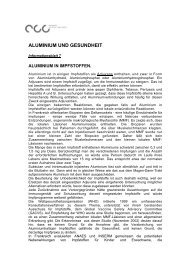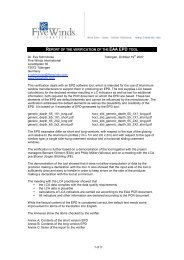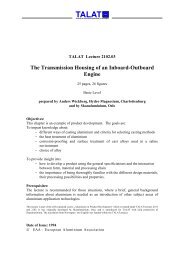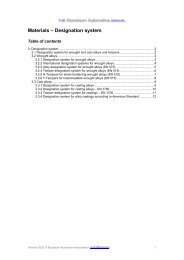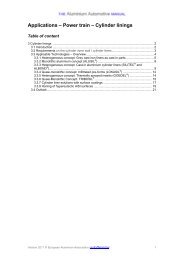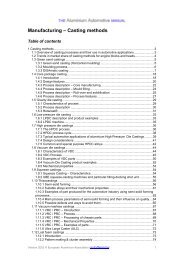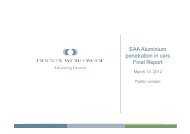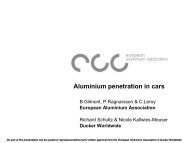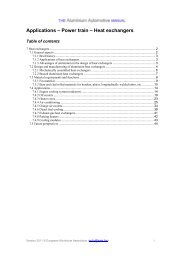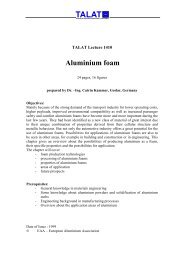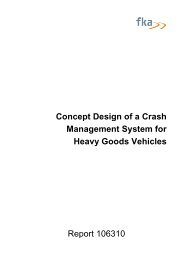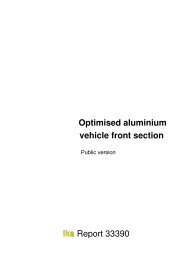aluminium in commercial vehicles - European Aluminium Association
aluminium in commercial vehicles - European Aluminium Association
aluminium in commercial vehicles - European Aluminium Association
Create successful ePaper yourself
Turn your PDF publications into a flip-book with our unique Google optimized e-Paper software.
EUROPEAN ALUMINIUM ASSOCIATION ALUMINIUM IN COMMERCIAL VEHICLES CHAPTER XI 151<br />
2.2.6. 5000 series alloys<br />
and elevated temperatures<br />
When held for long periods at<br />
elevated temperatures (between<br />
65°C and 200°C), <strong>alum<strong>in</strong>ium</strong>magnesium<br />
alloys conta<strong>in</strong><strong>in</strong>g<br />
more than 3% of magnesium<br />
undergo metallurgical changes<br />
that can lead to <strong>in</strong>tergranular<br />
corrosion if the two conditions<br />
below are both satisfied:<br />
• Precipitation of a cont<strong>in</strong>uous<br />
bead of Al Mg <strong>in</strong>termetallic<br />
8 5<br />
compounds occurs along the<br />
gra<strong>in</strong> boundaries (sensitization).<br />
These Al Mg precipitations are<br />
8 5<br />
anodic to the bulk material.<br />
• Presence of an aggressive<br />
medium, e.g. a sal<strong>in</strong>e solution on<br />
the bare surface of the material.<br />
This phenomenon has been studied<br />
many times with a view to gaug<strong>in</strong>g<br />
the <strong>in</strong>fluence of the follow<strong>in</strong>g<br />
parameters for sensitization:<br />
• The magnesium content and the<br />
production process largely determ<strong>in</strong>e<br />
the k<strong>in</strong>etics of sensitization of<br />
5000 series material. Proper routes<br />
to m<strong>in</strong>imize susceptibility are well<br />
established at suppliers.<br />
Filiform corrosion com<strong>in</strong>g from default <strong>in</strong> pa<strong>in</strong>t<br />
• Manufactur<strong>in</strong>g processes like<br />
form<strong>in</strong>g and thermal jo<strong>in</strong><strong>in</strong>g<br />
(weld<strong>in</strong>g) might reduce resistance<br />
of f<strong>in</strong>al product to sensitization.<br />
• The thermal load (i.e. temperature<br />
multiplied by time of exposure)<br />
is more important than the<br />
temperature alone. For example,<br />
if 65°C is often given as a limit <strong>in</strong><br />
catalogues or manuals, it takes<br />
two years to sensitize a 5086<br />
alloy at that temperature, while<br />
at 100°C, several months are<br />
necessary. The fastest sensitizations<br />
are generally observed<br />
between 130°C and 150°C.<br />
But even if a material is sensitized,<br />
corrosion will only happen<br />
<strong>in</strong> aggressive environments, i.e.<br />
when a corrosive electrolyte gets<br />
<strong>in</strong> contact with the metal surface.<br />
Experience has confirmed this.<br />
There are road tankers for heavy<br />
fuel oil, which have seen 20 years<br />
and more of service, runn<strong>in</strong>g 8 to<br />
10 hours a day, which is at least<br />
50,000 hours of cumulative<br />
operation at 65-70°C.<br />
As a general guidel<strong>in</strong>e, the use of<br />
alloys with a maximum of 3% of<br />
magnesium is strongly recommended<br />
where exposure for long<br />
periods to temperatures <strong>in</strong> excess<br />
of about 75°C occurs. When the<br />
use of 5000 alloys with higher<br />
Mg content is desired, consultation<br />
with the material producer is<br />
necessary and their applicability<br />
must be evaluated <strong>in</strong> detail, tak<strong>in</strong>g<br />
<strong>in</strong>to account the thermal<br />
exposure of the part dur<strong>in</strong>g its<br />
total lifetime.<br />
2.2.7. Other forms of corrosion<br />
Other forms of corrosion do exist,<br />
but the alloys and tempers most<br />
currently used <strong>in</strong> <strong>commercial</strong><br />
<strong>vehicles</strong> are not prone to these<br />
types of corrosion.<br />
2.3. Further references<br />
• Corrosion of <strong>alum<strong>in</strong>ium</strong>,<br />
C. Vargel, ed. Elsevier<br />
• www.corrosion-<strong>alum<strong>in</strong>ium</strong>.com



